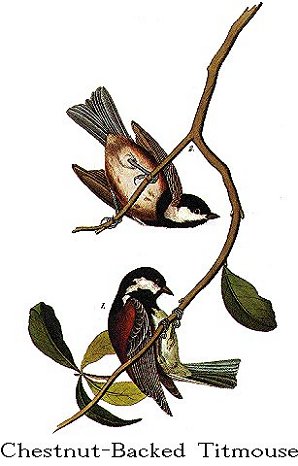
| Family X. PARINAE. TITS. GENUS I. PARUS, Linn. TIT. |
Next >> |

Family |
CHESTNUT-BACKED TITMOUSE. [Chestnut-backed Chickadee.] |
| Genus | PARUS RUFESCENS, Towns. [Parus rufescens.] |
Mr. NUTTALL'S notice respecting the present species is as follows:--
"The Chestnut-backed Titmouse is seen throughout the year in the forests of
the Columbia, and as far south as Upper California, in all which tract it
breeds, forming, as I have some reason to believe, a pendulous, or at least an
exposed nest, like some of the European species. It is made of large quantities
of hypna and lichens, and copiously and coarsely lined with deer's hair and
large feathers, such as those of the Grouse and the Jay. They are commonly seen
in small flocks of all ages in the autumn and winter, when they move about
briskly, and emit a number of feeble querulous notes, after the manner of the
Chickadee, or common species, Parus atricapillus, but seldom utter any thing
like a song, though now and then, as they glean about, they utter a t'she, de,
de, or t'dee, t'dee, dee, their more common querulous call, however, being like
t'she, de, de, vait, t'she, de, de, vait, sometimes also a confused warbling
chatter. The busy troop, accompanied often by the common species, the Regulus
tricolor, and the small yellow-bellied Parus, are seen flitting through bushes
and thickets, carefully gleaning insects and larvae for an instant, and are then
off to some other place around, proceeding with restless activity to gratify the
calls of hunger and the stimulus of caprice. Thus they are seen to rove along
for miles together, until satisfied or fatigued, when they retire to rest in the
recesses of the darkest forests, situations which they eventually choose for
their temporary domicile, where in solitude and retirement they rear their
young, and for the whole of the succeeding autumn and winter remain probably
together in families. When the gun thins their ranks, it is surprising to see
the courage, anxiety, and solicitude of these little creatures: they follow you
with their wailing scold, and entreat for their companions in a manner that
impresses you with a favourable idea of their social feelings and sympathy."
Mr. TOWNSEND says, that "the Chinook Indians call this species a kul. It
inhabits the forests of the Columbia river, where it breeds and goes in flocks
in the autumn, more or less gregarious through the season. The legs and feet
are light blue."
PARUS RUFESCENS, CHESTNUT-BACKED TITMOUSE, Towns. Journ. Acad. Nat. Sc.
Philadelphia, vol. vii. p. 190.
CHESTNUT-BACKED TITMOUSE, Parus rufescens, Aud. Orn. Biog., vol. iv.p. 371.
Adult Male.
Bill very short, straight, strong, compressed, rather acute; both mandibles
with the dorsal line slightly convex, the sides sloping and convex, the edges
sharp, the tip of the upper scarcely longer. Nostrils basal, roundish,
concealed by the recumbent feathers. Head large, ovate; neck short; body rather
robust. Feet of ordinary length, robust; tarsus compressed, with seven anterior
scutella, and two lateral plates meeting behind so as to form a thin edge; toes
large, the three anterior united as far as the second joint, the hind one much
stronger, and with its claw as long as the third. Claws large, arched, much
compressed, acute.
Plumage blended, tufty, unglossed. Wings of moderate length, the fourth
and fifth quills equal and longest, the sixth scarcely shorter, the third and
seventh equal, the second and eighth equal, the first very short, being only
half the length of the second. Tail long, slender, arched, very slightly
emarginate, or with its tip divaricate, of twelve rather narrow feathers.
Bill brownish-black, with the edges and tip paler. Feet greyish-blue;
claws paler. Head and neck, and fore part of the sides, dark brown, with a
broad longitudinal band of white on each side, from the bill under the eye,
curving up on the shoulder, and almost meeting on the back; which, including the
rump, is bright chestnut, as are the sides under the wings; the middle of the
breast and abdomen greyish-white, the lower tail-coverts tinged with chestnut.
Wings and tail brownish-grey, the smaller coverts tinged with chestnut, the
secondary coverts margined and tipped with greyish-white, of which colour also
are the outer edges of the quills, except the first; tail-feathers faintly
margined with bluish-grey.
Length to end of tail 4 1/2 inches; wing from flexure 2 3/8; tail 1 11/12;
bill along the ridge (4 1/2)/12; tarsus (7 1/2)/12; hind toe (3 1/4)/12, its
claw 4/12; middle toe (4 1/2)/12, its claw (2 3/4)/12.
Adult Female.
The Female is similar to the male.
| Next >> |